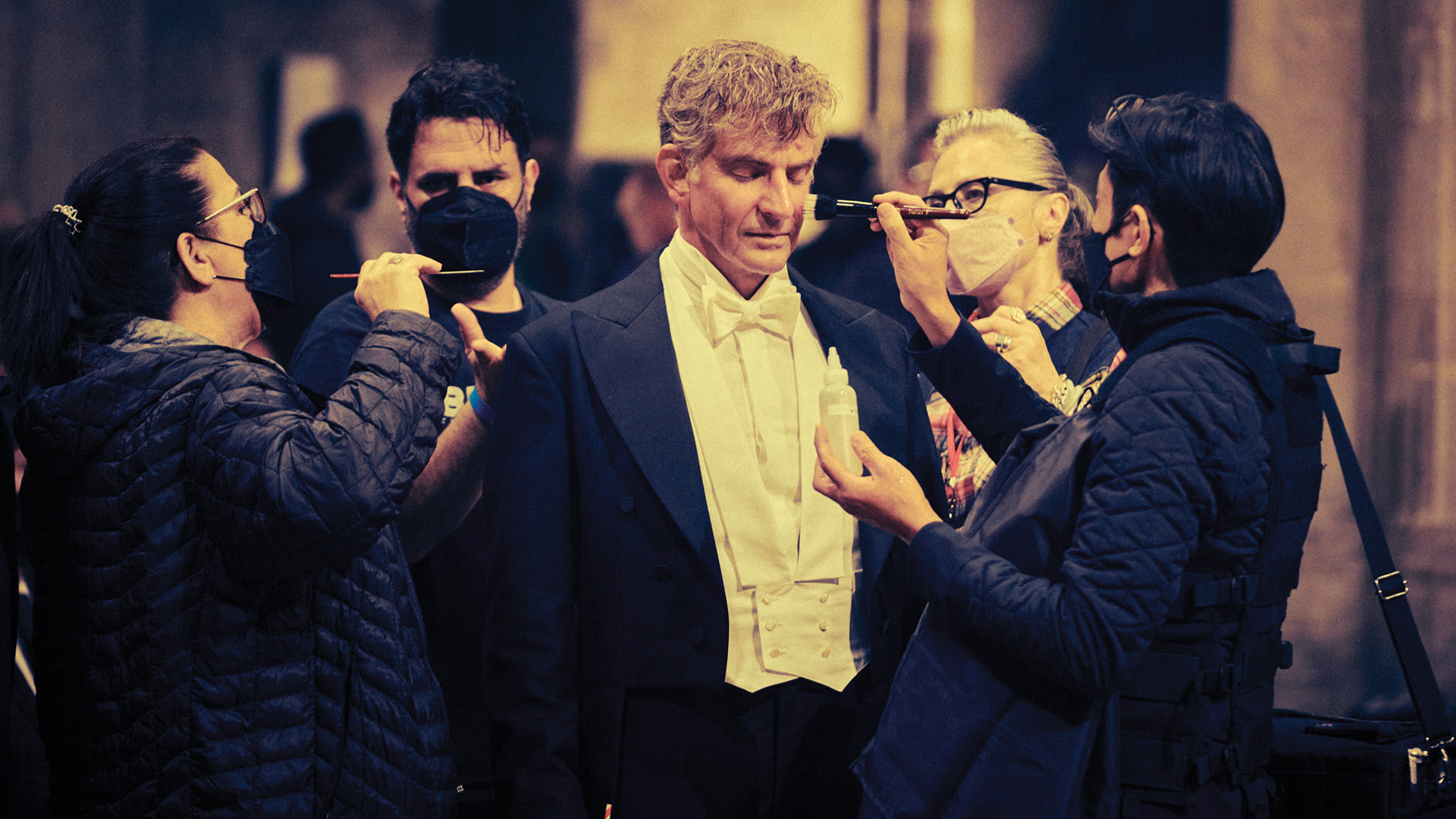Crafting a Symphony of Lifetime Looks
by the Make-up & Hair Departments
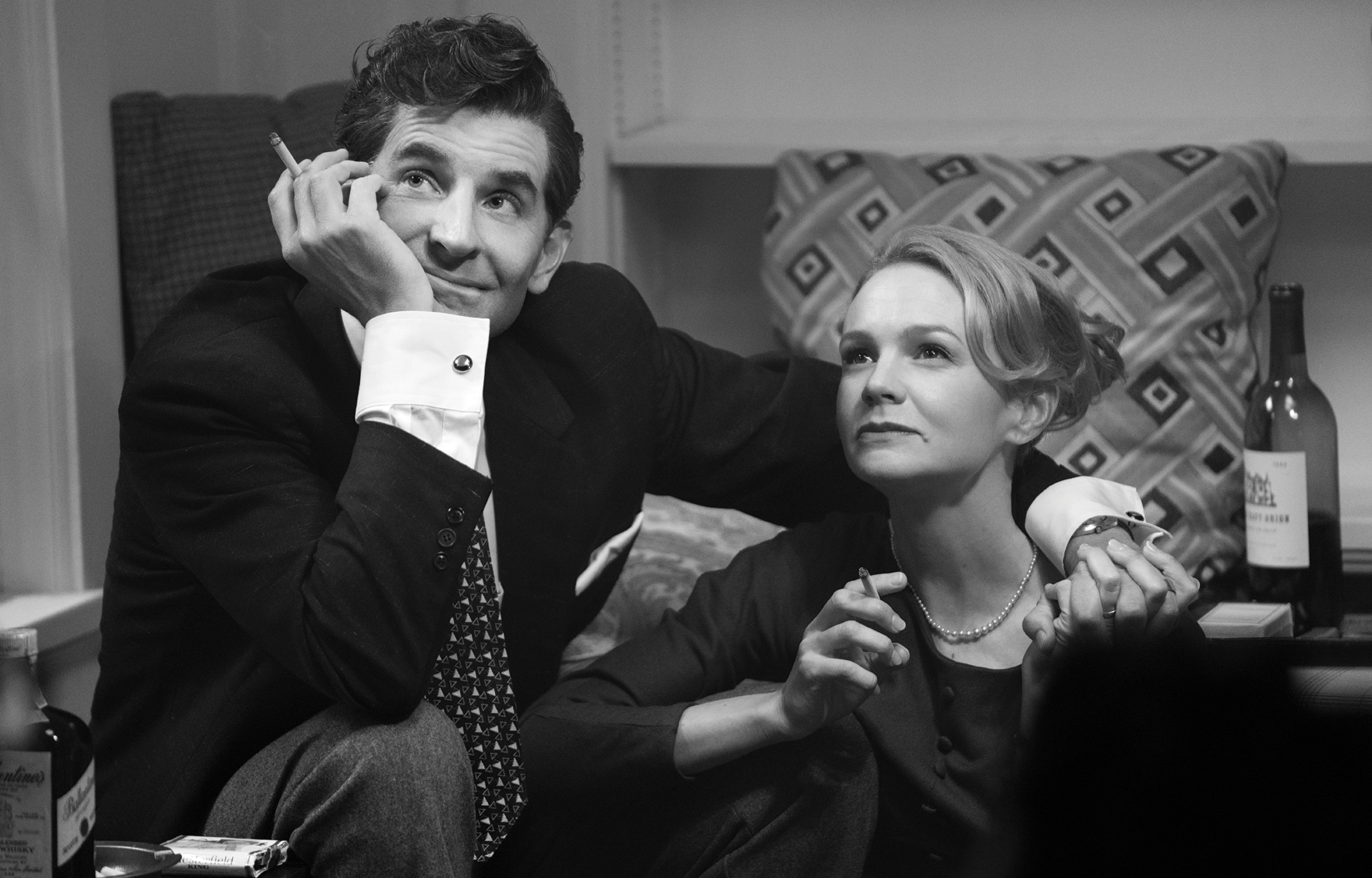
Kazu Hiro: Prosthetic Make-up Artist to Bradley Cooper
Maestro is a film that delves into the life of Leonard Bernstein and his wife Felicia Montealegre. The narrative spans from 1943 to 1989, capturing moments from when Leonard, affectionately known as Lenny, was 25 up until he was 71 years old. Leonard Bernstein stands out as one of the most remarkable composers, conductors, and educators in history, having played a pivotal role in shaping American music.
I recall watching a documentary about Leonard Bernstein early in my career in Japan, roughly 35 years ago. In it, he emphasized the immense commitment and dedication required to excel in any field. Lenny’s passion and drive resonated with me deeply, inspiring me to pursue my dreams with unwavering determination. I always harbored a hope that one day I’d have the opportunity to work on a film dedicated to him.
My wish seemed to be on the horizon when Bradley Cooper approached me in February 2020 about Maestro. I later discovered that Bradley had been collaborating with Guillermo del Toro on Nightmare Alley. Guillermo had confidently told Bradley, “Kazu is the only one who can do this.” We had initially planned to commence filming in March 2021. However, the onset of the pandemic led to several adjustments in our schedule. Finally, we started filming in New York in May 2022, later than expected but with no less enthusiasm.
A few years back, I got my hands on the Artec Space Spyder 3D scanner and Eva 2017. At that time, software and computers weren’t as fast as they are now. I initially used the scanner mainly for my fine art projects. However, as time went on, I began to integrate it more into my film projects. The technology’s speed and precision have definitely come a long way. In the beginning, I focused on scanning details around the eyes and mouth, merging them with a physical life cast. But as both the scanner and computer tech advanced, I found myself scanning larger portions of the face. In recent years, I’ve gotten the hang of full head scans. For tricky areas like the nose, nostrils and ears, which have deeper recesses that the scanner struggles with, I used a quick-setting dental silicone to create a life cast. Afterward, I’d 3D scan these casts. I’d then compile all this data in ZBrush to create a base for my sculpting. While a 3D scan captures about 90% of the detail compared to a silicone cast, it offers distortion-free results. Plus, you can do it with the subject’s eyes open! It’s made a world of difference when I’m sculpting, designing and fitting the pieces onto actors.
I crafted nose plugs that reshaped Bradley’s nose wings for a closer resemblance to Lenny. For comfort and flexibility, I 3D-printed the nose plug molds and used clear dental silicone for the final product. I then scanned Bradley wearing the plugs and integrated that data into the head cast. Before floating off any sculptures, I made sure to scan them for wig block creation. Most of the detailed work, like snap creation and positive mold crafting, was done using 3D scans and prints.
During the course of pre-production and filming, Bradley shed a significant amount of weight. This posed a challenge, especially for the facial features like the cheeks and chin. Keeping this in mind, I always had the scanner handy on set. Anytime there were changes due to his weight loss, I’d scan Bradley, then I sent the updated data to Vincent Van Dyke’s workshop. Their team would then print it out, create a plaster cast for sculpting, and make positive molds which they’d ship to New York. This workflow enabled me to re-sculpt new cheek and chin pieces during evenings and weekends. After finishing, I’d send them back to Vincent for the molding process. Having the scanner on hand proved to be a game-changer in saving time and ensuring accuracy.
I designed five distinct stages to depict Lenny’s evolving appearance over the years. For all stages, I incorporated vacuum-formed pieces to accentuate the ear helix and lobe.
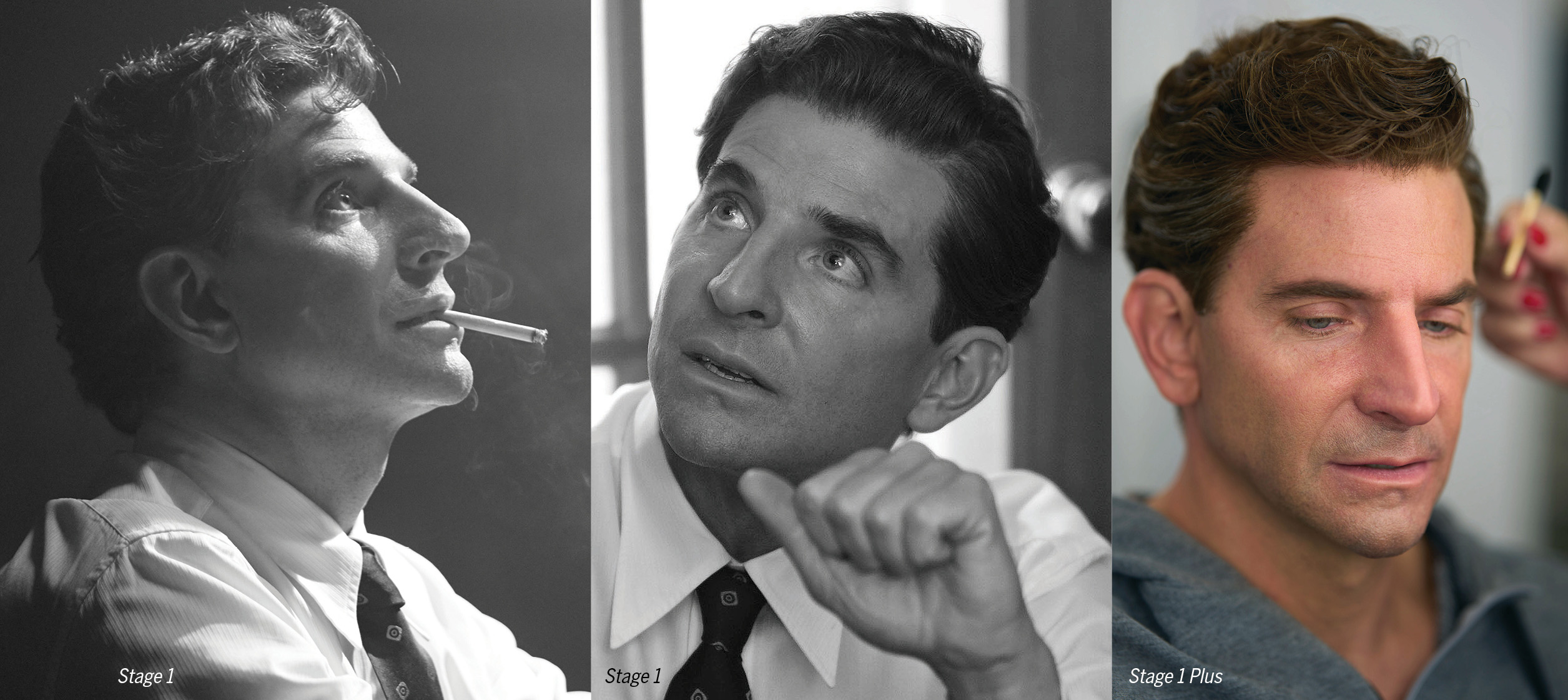 Stage 1 (1943-1946): Bradley had prosthetics for the nose, upper and lower lip, and chin. I used a silicone string attached to the wig clip, which I secured onto his temple hair, giving a subtle lift to the eye corners. Initially, his longer hair concealed the lifts on his cheeks, but Bradley opted for a shorter hair style. I experimented with various medical tapes to lift his jawline without tugging at his scalp. After some trial and error with different tapes, I settled on 3M Tegaderm. It was challenging to apply but allowed for stretching and compressing the skin. I used it from the mid-jaw to just in front of the ear, then blended and textured it using thickened PPI Beta Bond. Lori McCoy-Bell, the hair stylist, then applied the wig.
Stage 1 (1943-1946): Bradley had prosthetics for the nose, upper and lower lip, and chin. I used a silicone string attached to the wig clip, which I secured onto his temple hair, giving a subtle lift to the eye corners. Initially, his longer hair concealed the lifts on his cheeks, but Bradley opted for a shorter hair style. I experimented with various medical tapes to lift his jawline without tugging at his scalp. After some trial and error with different tapes, I settled on 3M Tegaderm. It was challenging to apply but allowed for stretching and compressing the skin. I used it from the mid-jaw to just in front of the ear, then blended and textured it using thickened PPI Beta Bond. Lori McCoy-Bell, the hair stylist, then applied the wig.
Stage 1 Plus (1955-1957): This stage retained the original prosthetics but without the facelift. The wig was positioned slightly higher, and after its application, I added gray shading to the temples.
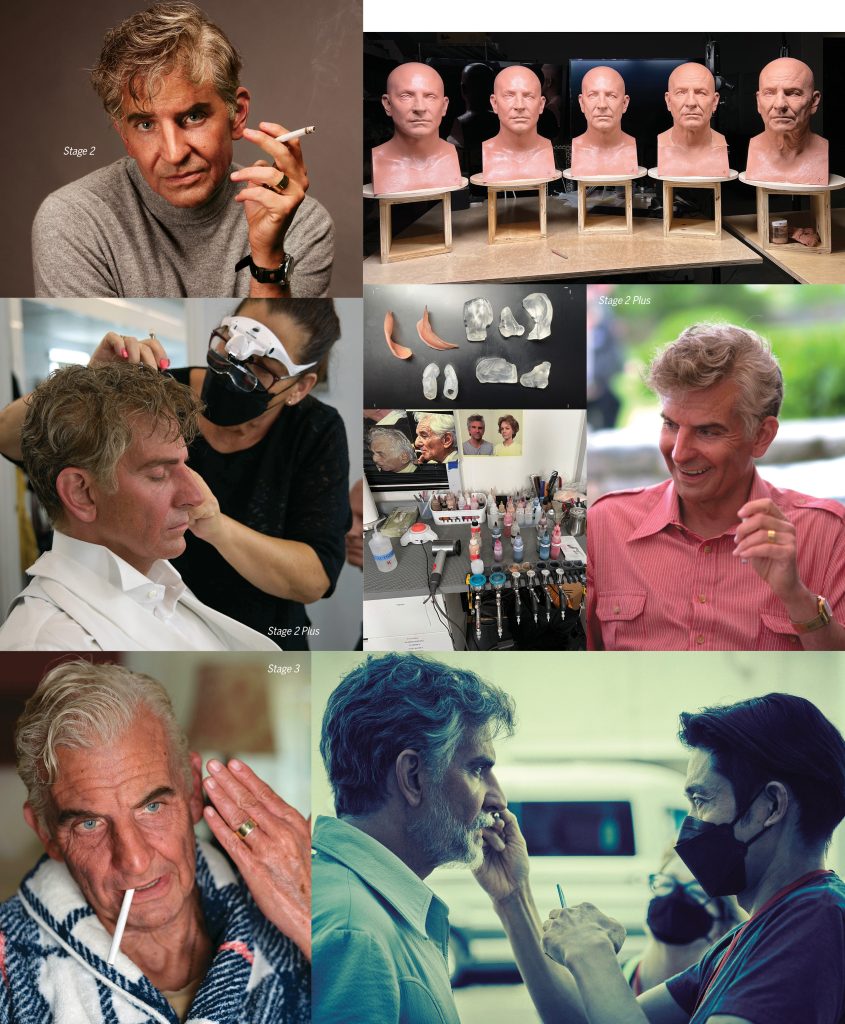 Stage 2 (1967-1971): This stage introduced prosthetics for the nose, upper and lower lips, chin, cheeks, neck, and earlobes. Given the closeness of Lenny’s hairline to Bradley’s, I applied a bald cap, leaving the nape exposed. This allowed Lori to seamlessly blend the wig with Bradley’s natural hair.
Stage 2 (1967-1971): This stage introduced prosthetics for the nose, upper and lower lips, chin, cheeks, neck, and earlobes. Given the closeness of Lenny’s hairline to Bradley’s, I applied a bald cap, leaving the nape exposed. This allowed Lori to seamlessly blend the wig with Bradley’s natural hair.
Stage 2 Plus (1977-1978): Initially, I designed and sculpted an older look but Bradley wanted Lenny to appear more youthful and “sexy” during this period, especially since Lenny was dating a younger man. I introduced a forehead piece to the existing Stage 3 look and added old-age stipple around the eyes, along with eyebrow hairpieces. This stage also had scenes featuring mustaches and beards.
Stage 3 (1989): This comprehensive stage included prosthetics for the top of the head, forehead, eyelids, nose, upper and lower lips/chin, cheeks, neck, back of the neck, shoulders, earlobes, hands, and arms. Due to Bradley’s sensitive eyes, we avoided contact lenses and minimized prosthetics around the eye area.
All in all, I crafted 137 individual pieces, ranging from small to large for test make-up, film test and filming.
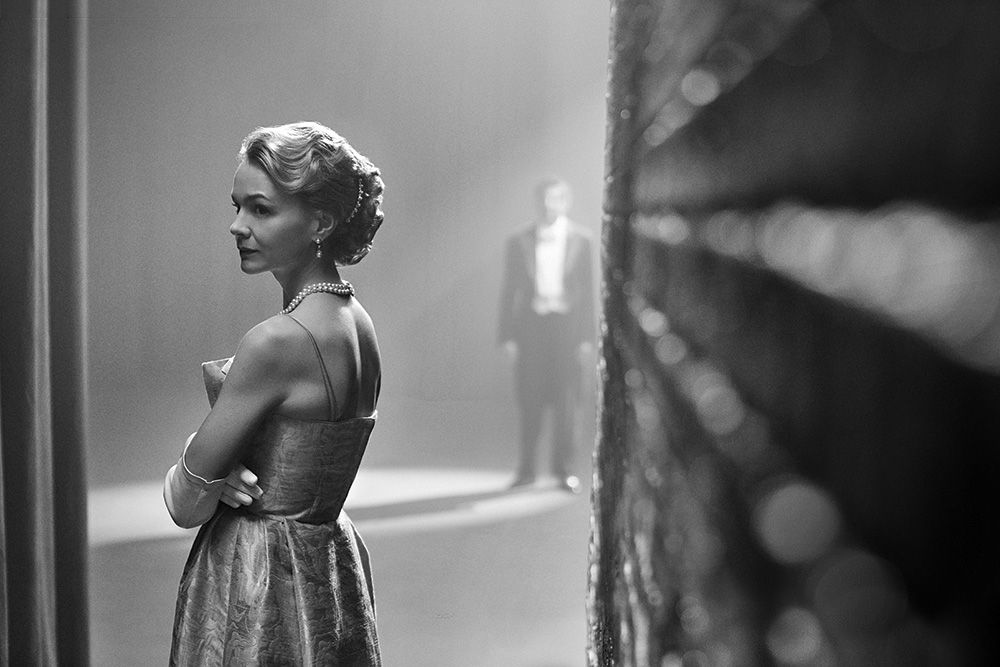
For the character Felicia Montealegre, portrayed by Carey Mulligan, I had sculpted two age stages. However, Bradley preferred a subtler aging process to portray her character. Siân Grigg and Duncan German took on the application of the aging stages. Duncan contributed by sculpting new nasolabial folds and neck pieces, utilizing the nose and earlobe pieces I had sculpted.
I also designed wigs based on images and sculptures of Lenny. Wigmaker Diana Choi ventilated each one. I had been working on a method to coat the lace front while maintaining flexibility. I requested Diana to use ultra-fine lace around the hairline. Once Lori styled the wig, I applied a light-curing fishing lure resin to ensure flexibility and prevent fraying. This also helped maintain dye vibrancy.
Most pieces were casted using Platsil gel 10, with 225% deadener or more. I adhered them using Telesis 9. Because of its slow drying time, a small fan proved invaluable. For Bradley’s comfort during long application sessions, I modified an ergonomic office chair with extension.
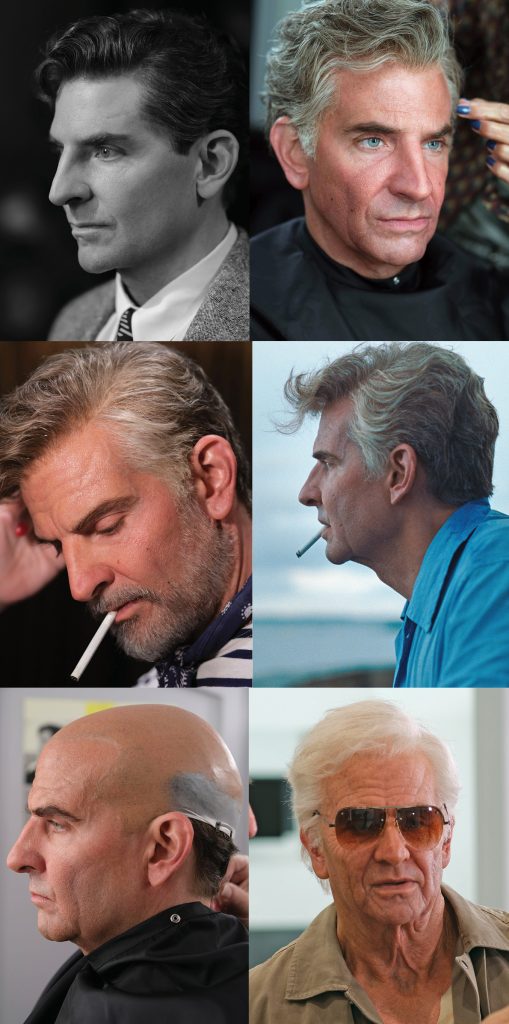
For coloring, I used a blend of Skin Illustrator flesh tone and Super Baldiez to cover some of his skin tone. For other colors, I mixed Bluebird FX Gloss & Matt sealer with acrylic paint, achieving a balance of translucency, elasticity, and sheen. For shorting application time, I designed a stand holding nine airbrushes and spray guns. This allowed me to switch between colors without constantly cleaning and refilling. I used Iwata CM-C, HP-TH, HP-TH2, and LPH-80. For convenience, I also assembled a mic stand with mini-tables for my glues and brushes so I can apply make-up myself efficiently.
For the younger stages, I used RCMA silicone make-up thinned with 244 for finishing touches, followed by sprays of Ben Nye Final Seal, Baldiez, and Bluebird sealers. On days when Bradley wore high-collar shirts, I applied extra sealers to withstand rubbing by costumes. Watching Bradley transformed into Lenny, when the costumes went on in the make-up trailer was awe-inspiring. His voice would change right away. However, it was challenging as Bradley wanted make-up applied before the crew call. Then he’d proceed to set up shots and rehearse. Most crew members had to wait for hours before being called back. Yet, Bradley was always considerate, ensuring his make-up remained intact. Given his multiple roles on set, touch-ups were kept to a minimum.
For the final two stages, I designed body suits. To save time, I printed a half-life-sized body form. After sculpting the body pads, I scanned the model, extracted sculptures, resized them to life-size in ZBrush, and printed them. Each body pad was molded and casted in foam latex. Vanessa Lee constructed the foundational body suits. After I glued on the padding, she covered the surface in spandex fabric.
In some scenes, Lenny’s exposed belly was a focal point. Wanting to concentrate on facial prosthetics, I entrusted Vincent Van Dyke with the task of creating a silicone body suit. This suit combined a silicone skin exterior with a foam latex core. It included a chest piece that seamlessly blended into the belly, connecting at the base of the neck piece. The suit was pre-colored, and individual hairs were meticulously punched in.
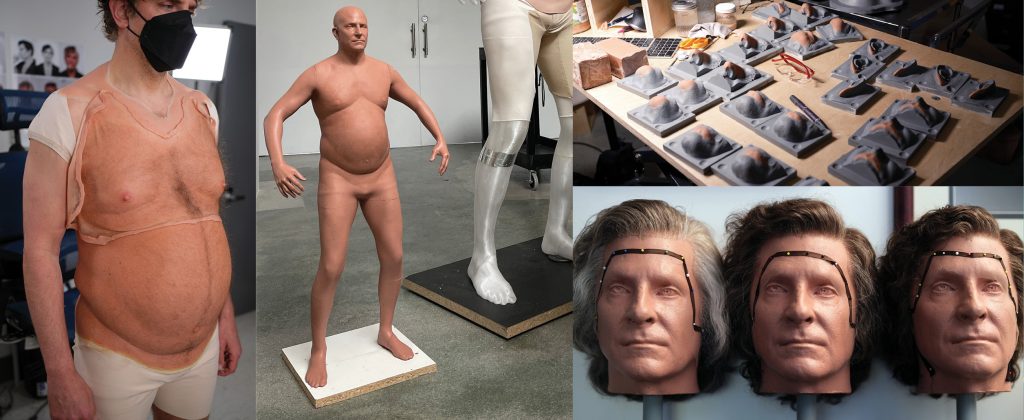
Vincent Van Dyke, along with his dedicated team, crafted all the molds and the silicone belly. They also sculpted the hand and arm pieces based on initial pieces I sculpted for testing. They were responsible for casting all the prosthetic pieces used in the film. Sasha Camacho demonstrated remarkable skills, ventilating Lenny’s eyebrows, mustache, and beard, and punching hair into his arms, chest, and belly.
During Lenny’s era, people appeared noticeably older than their contemporary counterparts. Lenny himself started using a suntanning light. Just before entering the time of our Stage 3 of aging, he underwent neck and eyelid surgeries. Lenny’s character was defined by his immense passion, love for many, bouts of insomnia, heavy smoking and drinking habit, and vigorous libido. He lived life to the fullest, exuding a larger-than-life presence. Our design aimed to reflect these facets of his personality.
Bradley was keen on keeping the make-up application team lean. Most of the application was done by myself and Megan Longmeyer. Megan played a pivotal role assisting me, preparing all necessary supplies, managing orders, setting up and tidying our station, and helping make-up removal. Lori was our go-to for all things related to wigs; she cut, styled, and applied them. Our team was truly stellar, and it was an absolute privilege collaborating with industry talents like Siân Grigg, Kay Georgiou, and Lori McCoy-Bell. At the onset of the production, Mike Fontaine and Vivian Baker were instrumental in setting up our trailer and ensuring a smooth start to filming. On particularly hectic days, we were fortunate to have the assistance of Mike Mekash, Richard Redlefsen, and Glen Griffin to help with the application.
I’ve had the privilege of collaborating with many talented individuals throughout my career, but Bradley stands unparalleled. He is without a doubt, the best person I’ve ever worked with. His boundless respect and consideration for every crew member were not just professional courtesies; they were genuine reflections of his character. Bradley’s transparency and relentless pursuit of perfection were awe-inspiring. Yet, what truly set him apart was his openness to collaboration and his unwavering commitment to elevating every aspect of the project. In a dynamic industry, his ability to foster an environment of fluidity, adaptability, and ceaseless improvement was truly remarkable. Every moment spent working with him was a lesson in excellence and a testament to his unparalleled dedication.
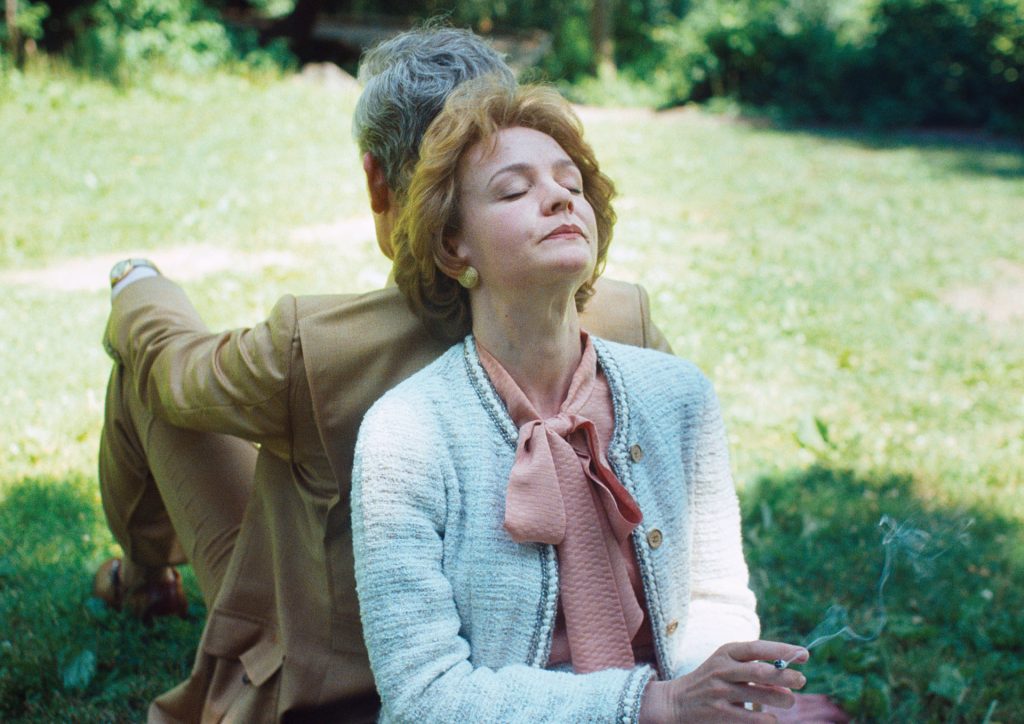
Lori McCoy-Bell: Hair stylist to Bradley Cooper
I devoted more than a year to studying and comparing images, capturing the nuances of Leonard’s hair throughout his life. We likely had every photo ever taken of him plastered on our walls for reference, spanning each period. This covered everything from how his hair formed waves or hung over his forehead to the styles he sported both in his personal life and at special events. I was acutely aware of the journey I needed to depict: from the luxuriant, thick, dark hair of his mid-20s to the subtle graying process, culminating in the almost completely white and thin hair of our final stage. The wigs needed to be impeccable, and I was eager to rise to the challenge. As artists, I’m sure you understand the thrill of such a creative endeavor.
One particular challenge was ensuring the wigs moved naturally during Leonard’s conducting scenes. Lenny was an expressive conductor; he’d sweat profusely, and his hair would sway and shift as he resonated with every beat. I wanted to capture the realism of sweat flying off his hair, all while maintaining its natural movement and integrity.
In total, I used four distinct wigs, with variations within each. I’d subtly adjust the gray levels by hand or alter the styling to depict the passage of time or to reflect where he was emotionally in his life. Through this meticulous attention to hair, I contributed to Bradley’s transformation into Lenny.
For styling, I opted for a wet set approach. Starting with clean hair and using setting lotion, I would comb the hair into waves and then pin these waves in place to dry. I finalized the set with a light misting of Ouai “Wave Spray.” This set, the curls and waves perfectly, allowing the hair to move and fall naturally. I used the same pin set for each stage, ensuring a consistent wave pattern. The wigs were adhered using Super Baldiez. I had ample time before filming to familiarize myself with its application, and now, I consider it one of my indispensable tools. One of the joys of filmmaking is continually learning and sharing new techniques.
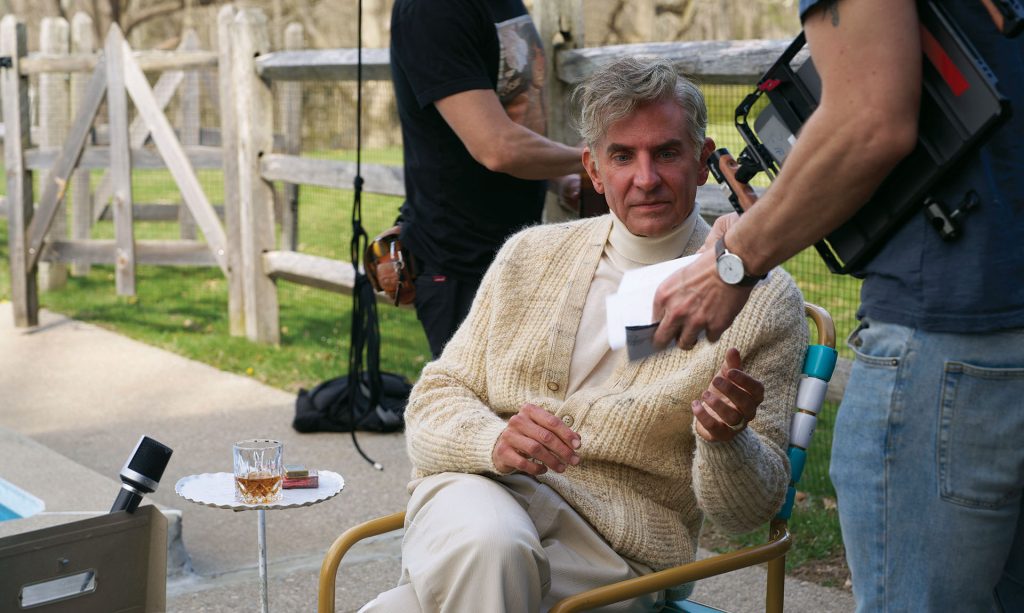 Stage 1 showcased his youngest look, shot in black-and-white. I employed a partial wig, adjusting his hairline and ensuring a consistent curl for all stages. Bradley’s own thick, wavy hair blended seamlessly with the wig after some styling. To conceal any gray in Bradley’s hair, I applied Reel Color Palette “Dark,” achieving a flawless on-screen look.
Stage 1 showcased his youngest look, shot in black-and-white. I employed a partial wig, adjusting his hairline and ensuring a consistent curl for all stages. Bradley’s own thick, wavy hair blended seamlessly with the wig after some styling. To conceal any gray in Bradley’s hair, I applied Reel Color Palette “Dark,” achieving a flawless on-screen look.
Stage 1 Plus used the same partial wig from the previous stage but covered a slightly later period. I let some of Bradley’s natural gray show, complementing the gray I had added to the sides.
Stage 2 involved a slightly different hairline, mimicking Lenny’s look from those years. This was almost a full wig, extending down to the mid-ear at the back. Because the gray hair had a wilder texture and was less dense, Kazu applied a partial bald cap to prevent any underlying hair from showing. I then blended the neckline with the wig using the Skin Illustrator “Hair Aging” palette and Reel Color Palette “Dark.”
Stage 2 Plus had a wig similar to the previous stage but with the hairline adjusted slightly. This hair style was a tad longer, with the top extending about two inches and an additional one-half inch over the ears. The blending and styling process was consistent with the previous stage.
Stage 3 was our most intricate. Our call times were often at 2 a.m., and this look took us five hours to complete. At this stage, his hair was almost entirely white and its thinnest. A full bald cap, painted by Kazu to show aging spots and texture, was employed. The wig was designed in two parts, allowing the neck piece to be secured first, with the three-quarter wig laid over it, ensuring a seamless look. This technique is especially effective in ensuring that the neck piece lays flat without sticking out.
Bradley was nothing short of exceptional. He always afforded us the time we needed, holding himself to the same high standards we set for ourselves. The commitment he showed, spending hours in the trailer and then transitioning to a full day of directing, was awe-inspiring.
Overall, this film was an incredible journey. Working alongside Kazu pushed me to my best, and the leadership of Kay Georgiou, Siân Griggs, and their teams was instrumental. Their dedication to perfection resonated throughout the production.

Siân Grigg: Department Head Make-up
My mother, a make-up artist, had extensive experience working with black-and-white. Since the first portions of the movie were filmed this way, she became the perfect primary source of research. Conversations about the brown and red sensitive studios, which required different make-up styles, were enlightening. Though technology has advanced, we still faced challenges with certain colors disappearing in black-and-white, particularly concerning lipsticks. We tested them rigorously to ensure the period-correct orange tones didn’t vanish. I created lipstick palettes for the crowd for each decade, but they were most crucial for the black-and-white sections.
Crowd fittings were essential to defining each decade. I had to advocate strongly for a make-up artist’s presence during these fittings. Nicky Pattison in NY and Sam Denyer in the UK, the crowd make-up supervisors, did stellar work. Each background artist had a fitting sheet with photos for their shoot day, showing their hair, make-up, and wardrobe. I reviewed each sheet, adding notes as necessary. Eyebrow shape, lip shape, and facial hair are crucial in distinguishing the different periods.
For the black-and-white section, crowd fitting photos were printed in both color and black-and-white. This helped illustrate the need for shading over color, suggesting a preference for neutral tones.
Facial hair played a significant role in setting the periods, from the pencil-thin mustaches of the ’40s to the bushy sideburns of the ’70s. Much of it was hand-laid, with lace pieces crafted by Justin Stafford.
I’ve collaborated with Carey multiple times and was eager to work with her again, especially since Kazu, an artist I’ve long admired, was involved. Aging Carey from 23 in 1946 to when her character passed away from cancer at age 66 in 1978 was an enticing challenge.
To help Carey appear younger for the black-and-white sections, Jean Black recommended Intraceuticals oxygen facials. The company generously supplied and trained me on their machine, which had a transformative effect on Carey’s youthful appearance. After several tests, I settled on mixing Saie Starglow 50/50 with Koh Gen Do base to give her skin a luminosity on screen. Working closely with our DOP, Matthew Libatique, we agreed that the effect was worth the careful lighting required. For close-ups, I used Too Faced Lip Injection Extreme to plump up fine lines.
Matt’s collaboration was invaluable, especially for Carey’s middle-age look in the ’60s. Having a supportive DOP can indeed make or break a make-up.
Although Kazu had designed Carey’s aging make-up, Bradley felt adjustments were needed after camera tests. Since Kazu was occupied with Lenny, Duncan Jarman, who was already assisting me with Carey’s old age make-up, sculpted smaller nasolabial pieces and a silicone neck to complement Kazu’s existing prosthetics. We also used Old Age Stipple for her hands and around the eyes and forehead.
In her final days battling cancer, Felicia still needed to look elegant yet heartbreakingly frail. We tested various approaches, but ultimately decided that Felicia, being a proud and sophisticated woman, would never let Lenny see her in a deteriorated state. Mark Bridges found references of Felicia in head scarves, which we recreated. I commissioned Cristina Patterson to create subtle sclera lenses to age and sicken her eyes, complementing a small hairpiece made with mohair.
Given that the cast portrayed real individuals, Bradley was deeply involved in all the design work to ensure accurate resemblances. Several principal characters aged throughout the film, achieved primarily through paintwork and flat mold pieces. For the Bernstein children, I had braces made by Fangs FX to assist with their progression through their teenage years and early 20s.
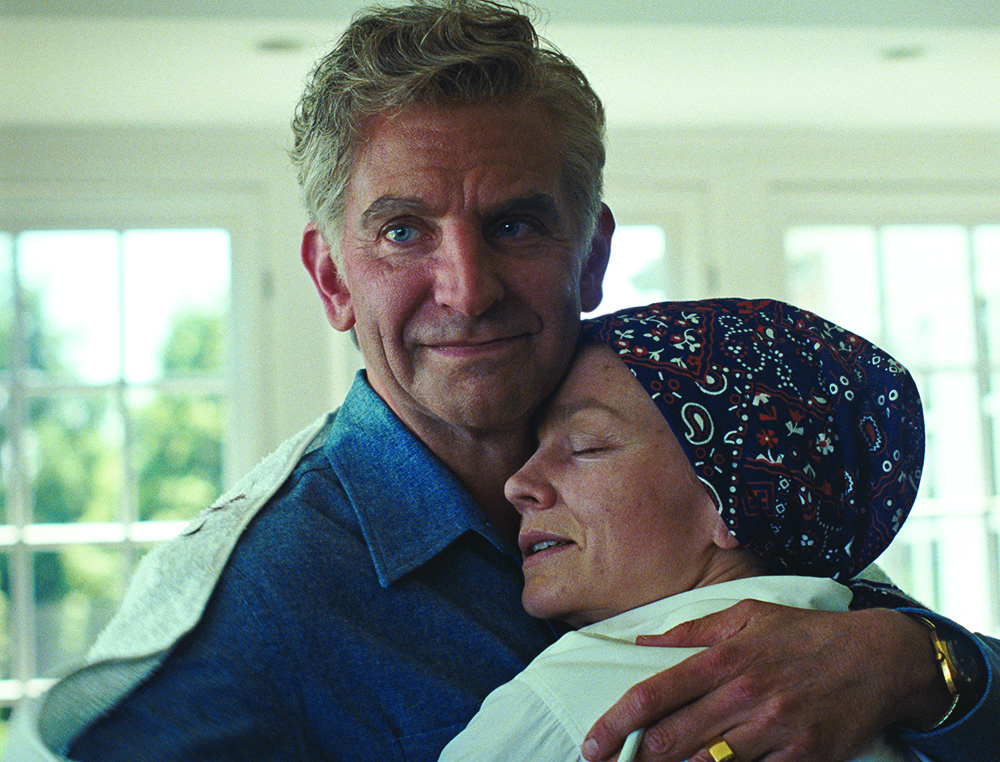 From the perspective of Kazu Hiro and Siȃn Grigg talking about Kay Georgiou’s Work:
From the perspective of Kazu Hiro and Siȃn Grigg talking about Kay Georgiou’s Work:
Siân Grigg and I had the pleasure of working with Kay Georgiou on Maestro who is incredibly talented in establishing various hair styles on the film for the actors. Georgiou tried to give the actors hair styles that matched their real-life counterparts whenever possible. This sometimes necessitated coloring, wigs, or hairpieces. She was provided photos by the Bernstein family. Considering the story spans five decades, Georgiou also extensively researched the eras and the individuals with whom Bernstein interacted. In preparation for filming, she communicated with the cast months in advance, asking them to grow out or refrain from coloring their hair to maximize the authenticity of their looks.
Bradley was deeply involved in crafting the looks for the cast. He preferred using the cast’s natural hair whenever feasible. Most of the time, Georgiou adapted actors’ existing hair to fit their character’s style. However, in some instances, her team had to resort to wigs, extensions, or even thinning out the actor’s hair to reflect aging.
A significant challenge of the film was depicting the aging of the Bernstein family and several other characters over the story’s timeline.
The Bernstein children, portrayed by various actors from infancy to adulthood, had multiple looks throughout the film. At certain points in the story, Georgiou’s team used temporary extensions on both Alex and Jamie Bernstein.
For Felicia, whose looks spanned from the 1940s to the 1970s, the real Felicia underwent numerous hair style and color changes throughout her life. After discussions with Bradley about her appearance and ensuring that both Lenny and Felicia aged harmoniously, Georgiou limited the number of styles she had. Her youngest look in the ’40s and her eldest in the ’70s were achieved with wigs, while her styles during the ’50s and ’60s were based on her natural hair, dyed to resemble Felicia’s original color.
All crowd members underwent pre-fittings. Female extras received period-appropriate hair styles based on what their natural hair could accommodate, though Georgiou’s team occasionally used wigs. Male extras were given haircuts suited to the era they depicted. Sometimes, Georgiou asked them to grow out their hair before filming. In certain cases, this meant they had to be fitted with wigs or hairpieces. Her team’s collaboration with the extras casting department was invaluable; provided them with detailed information and visual references for the desired looks.
Georgiou’s team used approximately 150 wigs during production. Bradley, a hands-on director, offered unwavering support and collaboration throughout the process. •
Make-Up Department Crew
Jackie Risotto, co-department head
Elisa Tallerico, make-up artist
Duncan Jarman, prosthetic artist
Nicky Pattison Illum, crowd make-up supervisor NY
Dawn Tunnell, crowd make-up NY
Sam Denyer, crowd make-up supervisor UK
Hair Department Crew
Jameson Eaton, key hair stylist
Amanda Duffy, crowd key hair stylist
Jimmy Goode, hair stylist
Lou Sheppard, crowd supervisor UK

